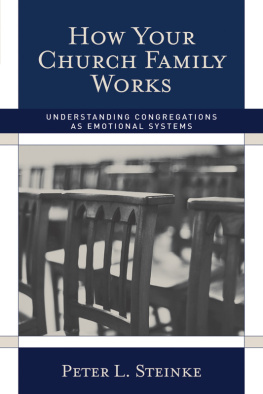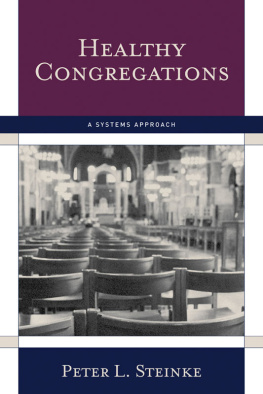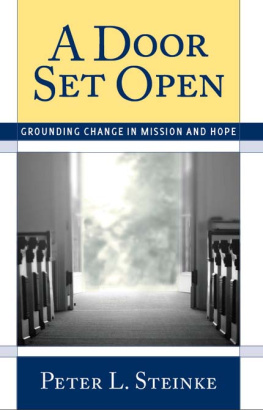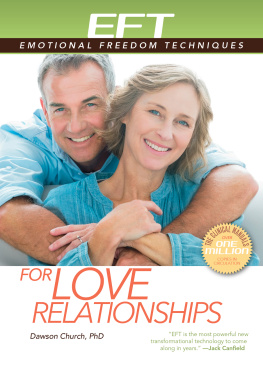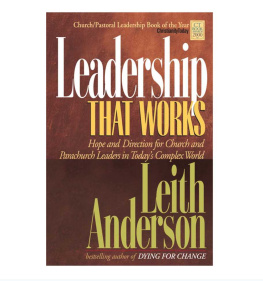How Your Church Family Works
Understanding Congregations as Emotional Systems
Peter L. Steinke
Copyright 1993, 2006 by the Alban Institute, Inc. All rights reserved. For permission to reproduce, go to www.alban.org/permissions.asp or write to the address below.
The Alban Institute
2121 Cooperative Way, Suite 100
Herndon, VA 20171
Unless otherwise indicated, scripture quotations in this volume are from the New Revised Standard Version of the Bible, copyright 1989 by the Division of Christian Education of the National Council of the Churches of Christ in the United States of America. Used by permission. All rights reserved.
The author gratefully acknowledges the following:
The Saturday Evening Post for permission to reprint the Erickson cartoon on p. 7 (copyright 1978). Robert Nisbit for permission to quote from Elting E. Morisons chapter in his book Social Change (Basil Blackwell, 1972). HarperCollins Publishers for permission to quote from Frederick Buechners Telling Secrets (1991) and Aldous Huxleys The Devils of Loudon (1986). Zondervan Publishing House for permission to quote from Paul Brand and Philip Yanceys Fearfully and Wonderfully Made (1987).
Cover design by Concept Foundry.
Contents
How shall we account for the extraordinary increase in church and synagogue upheavals during the past twenty years? One clue to the origins of this expanding chaos may be that it is absolutely ecumenical. During the past two decades that I have been engaged in counseling religious institutions and their leaders, I have observed this contagion spread to all four corners of our country, infecting every religious denomination with which I come into contact with the possible exception of the most rigidly fundamentalist denominations. It is precisely this universality that leads me to suspect we are dealing with a phenomenon that is not basically religious but which is reflective of society at large.
The late Dr. Murray Bowen had a theory he called societal regression. It was his view that from time to time the chronic, free-floating anxiety that was, to some extent, always around spiked. Such periods are marked by a rise in terrorism, fundamentalism, cults, and a general shifting in the individuality/togetherness scale towards the stuck-togetherness end of the continuum. In such climate the focus shifts toward pathology rather than strength, safety becomes more important than adventure, adaptation is towards the dependent, and empathy becomes more important than responsibility. The resulting atmosphere is toxic to well-defined leaders.
During such periods it is the people who are themselves most anxious who are quickest to be affected by the regression in society and who, therefore, will do more acting out everywhere. This is particularly true, I believe, in religious institutions, smack on the boundary between family and society, caught in the vortex of this escalation, as parishioners and congregants displace their personal and family anxieties into institutions that are already caught up in the collective anxiety of the human family. They thus seek salvation from a system too issue-driven to gain the distance necessary to provide a safe haven. The result necessarily leads to disappointment and frustration, if not anger and rage, and for the minister or rabbi a perpetual autodaf.
Fortunately, out of that same complexity of conditions has also come a new way of thinking about human relationships that can help religious leaders understand the waves that are engulfing them and here and there perhaps even turn the tide. The family model is not simply a new technique, but a fundamentally new way of thinking about relationships. It is based on the idea that relationship systems are not built up out of the personalities of those who belong to them, but rather that the personalities in any institution express themselves according to the forces within the system and their position within those forces.
This way of conceptualizing, sometimes called field theory, is in harmony with the scientific leading edge, especially in the disciplines of astronomy, physics, and biologyall of which have come to recognize that reality may have more to do with relationships than with some so-called basic nature. One important awareness that has come out of this anti-reductionist shift in paradigms is the awareness that structures (atoms, genes, crystals, and institutions) possess a kind of self-organizing quality to them. The second is that structures have a way of persisting in their form from generation to generationa form that is not easily changed by simply analyzing or rearranging their parts.
People, however, do differ from planets, atoms, and genes in one important manner: they have the capacity to see the structures in which they are embedded and to differentiate themselves from the forces which influence them.
This is the direction in which the Alban Institute has struggled to steer for some time now, and in Peter Steinke we have found an exceptionally experienced and well-qualified navigator.
Rabbi Edwin H. Friedman, D.D.
1993
What began as a venture in continuing education became a life-changing event for me. I met Dr. Edwin Friedman at a three-day workshop in Austin, Texas. In a conversation with him, he mentioned his new Post-Graduate Seminar in Family Emotional Process that he was leading in Bethesda, Maryland. Intrigued by his insights and style of teaching, I attended the workshop in 1988, not intending to repeat it. But the allure of the concepts and the new way of viewing the world kept me returning for nine years until Dr. Friedmans death in 1996.
In 1991, I asked him why he didnt abridge his book Generation to Generation and write a short version of it so that it could be available to more people. He saw no need to do it since the book had had multiple printings. You, he said to me, could write the short version. With his encouragement, I contacted the Alban Institute and How Your Church Family Works was written.
That was 15 years ago. Surely there are a few things that I might change in this volume today. One would be a clear statement about how differentiation is how one handles oneself. Some heard the concept of differentiation and began to think of the undifferentiated people they know or have had to engage. In fact, I think Dr. Friedman would say the level of differentiation of others, especially if low, is only significant if it affects your functioning. What is primary is your own response, your own capacity to base behavior in principle.
People have reported to me that the value of the book extends beyond their lives in their congregations. The concepts have been helpful to them in other relationships and situations. What I describe as happening in congregations happens at home and at work. Another value people have aquired from the book is that when they and others now look at a circumstance or event, they do it, as one person said, looking out the same window and standing on the same platform. They have a common way to see things and to understand life.
If people have found such value in the book, I wouldnt change much. What I would add to the text today, though, would be the connection I see between differentiation and the stewardship of life. They both are about managing what has been given. I hope the reader will see how self-management is crucial to the life we have been given. For we are called to be stewards of self and of the emotional system called the church.
We think of the church in terms of biblical metaphors. It is the body of Christ, the New Israel, and shepherd and flock. Speaking personally, we use the metaphors of warmth and relationship to describe the churcha community, a family, and a gathering of caring people. Metaphorically, the church is depicted in splendor.
Next page
